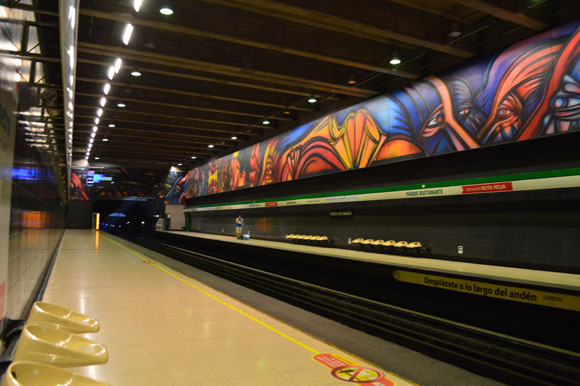

|
San Miguel, a Santiago BarrioI woke up early in the morning after a night of little sleep. The excitement of the day before stayed with me until late into the night. I went out and got some coffee, then walked over to the Parque Forestal, finding a quiet bench to sit and enjoy the city as it slowly began to wake up. Then it was time for a rush hour ride on the subway. Santiago has an excellent Metro with an extensive network of subway routes. The trains are clean and modern, running just a few minutes apart. They are also extremely popular and packed tightly with commuters, making it a challenge to squeeze through the doors. At first I thought this was just because it was rush hour, but later I found they are almost always like this. I bought a Bip card, which gave me easy and unlimited access, and started to find my way around the subway system. From Plaza Italia, where the subway station is known as Baquedano, I took Línea 1 to Los Heroes, going underneath the heart of Santiago. From Los Heroes I transferred to to Línea 2 and took the long ride out to Departamental in the southern part of the city. This area is known as San Miguel, a working class neighborhood of small homes and rows of four-story apartment blocks. San Miguel is far off the beaten track, unknown to most tourists. What drew me to this humble barrio was the Museo al Cielo Abierto, the Open Air Museum. Started in 2009, the Museo al Cielo Abierto has transformed dozens of grim apartment blocks into gigantic four-story murals that tell stories of the people, the culture, the mythology, and the history of Chile. Taken together, they form a fascinating collection of "arte callejero," the art of the street. In just a few years, they have also transformed the sense of pride and community that is strongly felt in this neighborhood. The influence of the great Mexican muralists Diego Rivera, José Orozco, and David Alfaro Siqueiros is evident here. Many of the murals portray a vivid political statement, a social commentary that rises high above the street. Others portray a powerful connection to the natural world: a life size breaching whale, the tragedy of a forest cut down, or the sweet childhood memory of a treehouse hideaway. My favorite mural was "Los Prisioneros," on the Avenida Departamental. An homage to the punk rock group of the 1980s (La Voz de los Ochenta), the mural depicts the members of Los Prisioneros looking out into their hometown barrio of San Miguel. Los Prisioneros were among the early voices of dissent against the Pinochet regime, at a time when any sign of defiance could result in beatings, torture, and murder. Another favorite mural was "Sanación Equilibrio," a serene Buddhist themed artwork with an intricate mandala at its center. In addition to the beauty of the mural, the building also had a small plaza in front of it with some welcoming benches and shady trees. I rested here for a while, reading a book and keeping cool as the late morning sun began to heat up Santiago. As part of my immersion into Chilean culture, I've been reading a contemporary novel called El Arte de la Resurrección, (The Art of the Resurrection) by Hernán Rivera Letelier. The Spanish is daunting, with many unfamiliar Chilenismos, and also some very creative use of the language. I'm intrigued by the difficulties and the challenge of tackling this work. Much of it takes place in the Atacama Desert, where I will be visiting in the upcoming days. It is a novelized story of the "Christ of Elqui," a real-life man who walked the desert in the 1930s and 1940s under the illusion that he was the resurrection of Jesus Christ. Sitting here reading this novel brings about an inner calm and appreciation for the place I am at. I look up from the book occasionally and glance around at my surroundings, feeling a sense of awe at being in South America.  The Metro station at Parque Bustamante is painted with the murals of Alejandro "Mono" González On the way back to the central city, I took the long way on the subway so I could visit the Parque Bustamante station, on the Línea 5. The walls of the subway station are adorned with massive murals that run the length of the train platforms. They were painted by Alejandro "Mono" González, the artist who was the Art Director and creative force behind the Museo al Cielo Abierto in San Miguel. It seemed an appropriate tribute to his genius and creativity to visit one of his earlier works. |
||||||||||
|
|||||||||||
 |
|||||||||||
|
© 2015 Michael Hanrahan
|
|||||||||||


